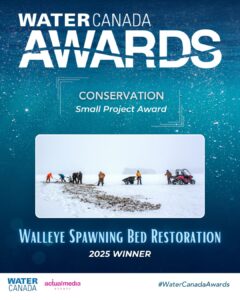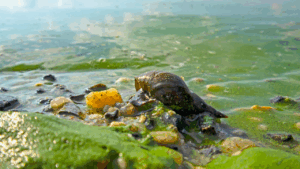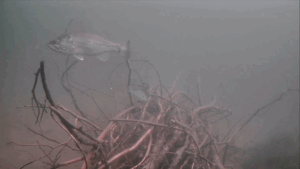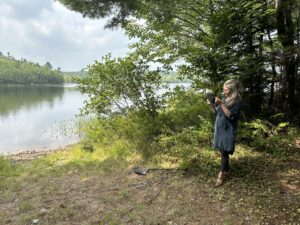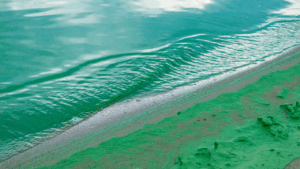October 17, 2025 — A major win for walleye conservation has landed the most prestigious award ever for Watersheds Canada, the 23-year-old national conservation charity that inspires community-wide involvement in logistically, and often physically, challenging habitat restoration work, even in the wintertime. Last night, at the Water Canada Awards, in Toronto, Ontario, Watersheds Canada staff proudly accepted recognition from nearly 200 water protection leaders. Watersheds Canada's Fish ... Read More
Buffer Zones to Prevent Harmful Algae Blooms
by Paige Jessup, Climate Change Resiliency Intern Each summer, harmful algae blooms are at the forefront of local news around the country. The danger to humans, pets, and livestock have increased public awareness but these blooms also have a profound ecological impact. Could buffer zones play a role in combating these algae blooms? Toxic algae blooms of most species of cyanobacteria thrive in warm, calm, high nutrient environments. With the increase of global temperatures due to climate ... Read More
The best before and after habitat photos ever!
Our Fish Habitat team doesn’t start by asking what is possible; we ask what needs to be done, and how we can partner with communities to make it happen. Grounded in practicality, research, and collaboration, our work takes direct action to restore critical habitat for native fish. Your donation today will help us continue this important work! Donate today to help us restore critical fish habitat in Ontario’s lakes and rivers! Watersheds Canada's fish habitat ... Read More
Leading freshwater conservation charity launches technology to protect Canada’s shorelines from climate change impacts
PERTH, ON — September 25, 2025 Watersheds Canada, a national freshwater conservation charity, has launched a new Climate Resiliency Report generator through their award-winning The Natural Edge shoreline restoration program. The new report generator will allow for locally-specific resources and stewardship action plans to be at the fingertips of those hard-hit by the impacts of climate change: waterfront communities. To ensure this new Climate Resiliency Report generator tool is ... Read More
Cyanobacteria and Public Health
by Paige Jessup, Climate Change Resiliency Intern Despite its name, blue-green algae is not actually algae - it is a type of bacteria called cyanobacteria that lives in fresh and marine water. Most species of cyanobacteria are unicellular and photosynthetic, meaning they use sunlight to produce their own food. Blue-green algae can reproduce rapidly in warm, slow-moving, nutrient rich environments. In the right conditions, these bacteria will rapidly reproduce and cause a bloom, spreading ... Read More
New Marginal Lands Initiative Offers Up to 90% Funding for Farmers // La nouvelle Initiative pour les terres marginales propose aux agriculteurs un soutien financier pouvant aller jusqu’à 90 %
New Marginal Lands Initiative Offers Up to 90% Funding for Farmers September 23, 2025 -- The Eastern Ontario Farm Stewardship Collaborative—which brings together Watersheds Canada, Conservation Authorities, Ducks Unlimited Canada, Forests Canada, Just Food, and other partners—is proud to launch the Resilient Agricultural Landscape Program (RALP) – Marginal Lands Initiative. This new funding opportunity will support farmers and rural landowners in implementing on-the-ground projects that ... Read More
Media Release – Lake Trout and Walleye Spawning Beds Restored Across Central-Eastern Ontario
September 16, 2025 - Watersheds Canada’s Fish Habitat team is delivering a series of spawning bed restoration projects this fall to promote the population growth of declining lake trout and walleye populations across Central-Eastern Ontario. After two projects in early September, the organization is now looking ahead to two more: one in a lake north of Kingston, and the other just south of Algonquin Park. These projects are delivered in partnership with lake communities that have identified a ... Read More
Resources for Property Owners
Watersheds Canada's education toolkit about septic systems: https://watersheds.ca/septics Septic System Basics for Homeowners: https://www.youtube.com/watch?v=04ZIjz8kAPw This video addresses the basics of how a septic system functions and provides best maintenance practices for homeowners. FOCA Cottage Country Septic System: https://www.youtube.com/watch?v=ix9nbF8qUrA In this video made by Federation of Ontario Cottagers’ Associations guides you through all the ... Read More
History of Cyanobacteria (Blue-Green Algae) in Canadian Waters
by Paige Jessup, Climate Change Resiliency Intern Cyanobacteria, or “blue-green algae”, are one of the old living organisms on earth, evolving from a group of microbes approximately 2.7 billion years ago. Cyanobacteria are thought to be the cause of one of Earth's mass extinctions called “The Great Oxygenation Event” which took place between 2.4-2.1 billion years ago and wiped out almost all life on earth (Aiyer, 2022). Cyanobacteria survived this extinction and eventually went through a ... Read More
The Consequences of Cyanobacteria on Freshwater Ecosystems
by Paige Jessup, Climate Change Resiliency Intern Cyanobacteria, also known as blue-green algae, is one of the oldest living organisms on earth and are generally unicellular. These organisms are photosynthetic and require sunlight, water, and nutrients such as nitrogen and phosphorus to reproduce. Due to current land use practices along Canada's shorelines, humans are opening up these organisms to these perfect conditions they need to reproduce each year and also to reproduce earlier in the ... Read More
- « Previous Page
- 1
- 2
- 3
- 4
- …
- 20
- Next Page »

